FINDING AREA OF IRREGULAR SHAPES
Subscribe to our ▶️ YouTube channel 🔴 for the latest videos, updates, and tips.
Find the area of each of these shapes. The diagrams have not been drawn accurately.
Problem 1 :
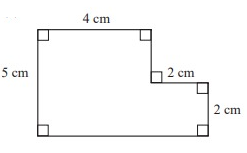
Solution :
By drawing a horizontal line, we can divide the given shape into two rectangles.
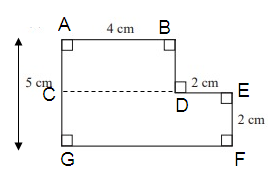
(1) ABCD is a rectangle
(2) CEFG is a rectangle
Area of the given polygon = Area of the rectangle ABCD + Area of the triangle DEFG
Area of the rectangle ABCD :
Length AB = 4 cm, AG = 5 cm
AG = AC + CG
5 = AC + 2
AC = 3 cm
Width AC = 3 cm
= length × width
= 4 × 3
= 12 cm2 --- (1)
Area of the triangle CEFG :
Length CE = (4 + 2) ==> 6 cm
Width EF = 2 cm
= length × width
= 6 × 2
= 12 cm2 --- (2)
Area of the given shape :
= (1) + (2)
= 12 + 12
= 24 cm2
Problem 2 :
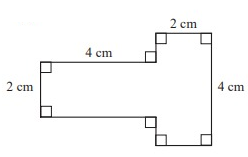
Solution :
By drawing a vertical line, we can divide the given shape into two rectangles.
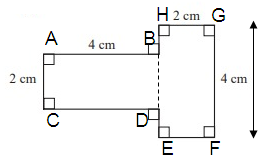
(1) ABCD is a rectangle
(2) EFHG is a rectangle
Area of the given polygon = Area of the rectangle ABCD + Area of the rectangle EFGH
Area of the rectangle ABCD :
Length AB = 4 cm
Width AC = 2 cm
= length × width
= 4 × 2
= 8 cm2 --- (1)
Area of the rectangle EFGH :
Length HG = 2 cm
Width GF = 4 cm
= length × width
= 2 × 4
= 8 cm2 --- (2)
Area of the given shape :
= (1) + (2)
= 8 + 8
= 16 cm2
Problem 3 :
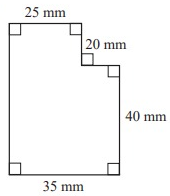
Solution :
By drawing a horizontal line, we can divide the given shape into two parts (rectangle and square) as shown below.
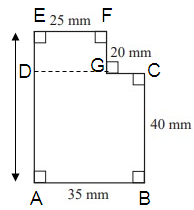
(1) ABCD is a square
(2) EFDG is a rectangle
Area of the given polygon = Area of the rectangle ABCD + Area of the triangle EFGD
Area of the rectangle ABCD :
Length AB = 35 mm
Width BC = 40 mm
= length × width
= 35 × 40
= 1400 mm2 --- (1)
Area of the triangle EFGD :
Length HG = 25 mm
Width GF = 20 mm
= length × width
= 25 × 20
= 500 mm2 --- (2)
Area of the given shape :
= (1) + (2)
= 1400 + 500
= 1900 mm2
Problem 4 :
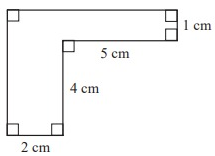
Solution :
By drawing a vertical line, we can divide the given shape into two rectangles.
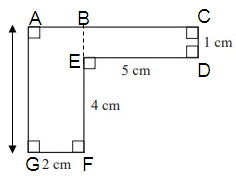
(1) ABGF is a rectangle
(2) BCDE is a rectangle
Area of the given polygon = Area of the rectangle ABGF + Area of the triangle BCDE
Area of the rectangle ABGF :
Length GF = 2 cm
Width BF = BE + EF
= 1 + 4
BF = 5 cm2
= length × width
= 2 × 5
= 10 cm2 --- (1)
Area of the triangle BCDE :
Length ED = 5 cm
Width CD = 1 cm
= length × width
= 5 × 1
= 5 cm2 --- (2)
Area of the given shape :
= (1) + (2)
= 10 + 5
= 15 cm2
Problem 5 :
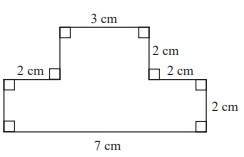
Solution :
By drawing a horizontal line, we can divide the given shape into two rectangles.
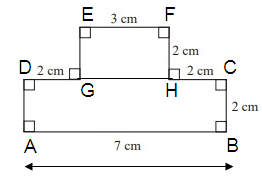
(1) ABCD is a rectangle
(2) EFHG is a rectangle
Area of the given polygon = Area of the rectangle ABCD + Area of the rectangle EFGH
Area of the rectangle ABCD :
Length AB = 7 cm
Width CB = 2 cm
= length × width
= 7 × 2
= 14 cm2 --- (1)
Area of the rectangle EFGH :
Length EF = 3 cm
Width FH = 2 cm
= length × width
= 3 × 2
= 6 cm2 --- (2)
Area of the given shape :
= (1) + (2)
= 14 + 6
= 20 cm2
Problem 6 :
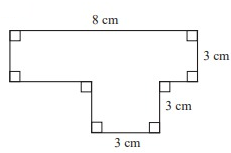
Solution :
By drawing a horizontal line, we can divide the given shape into two parts (rectangle and square) as shown below.
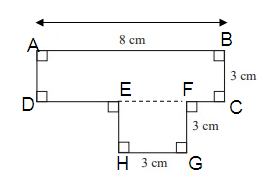
(1) ABCD is a rectangle
(2) EFGH is a square
Area of the given polygon = Area of the rectangle ABCD + Area of the square EFGH
Area of the rectangle ABCD :
Length AB = 8 cm
Width BC = 3 cm
= length × width
= 8 × 3
= 24 cm2 --- (1)
Area of the square EFGH :
= a2
= 3 × 3
= 9 cm2 --- (2)
Area of the given shape :
= (1) + (2)
= 24 + 9
= 33 cm2
Subscribe to our ▶️ YouTube channel 🔴 for the latest videos, updates, and tips.
Recent Articles
-
Finding Range of Values Inequality Problems
May 21, 24 08:51 PM
Finding Range of Values Inequality Problems -
Solving Two Step Inequality Word Problems
May 21, 24 08:51 AM
Solving Two Step Inequality Word Problems -
Exponential Function Context and Data Modeling
May 20, 24 10:45 PM
Exponential Function Context and Data Modeling